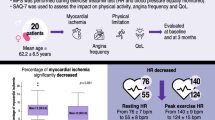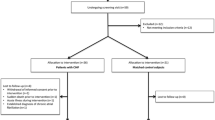Summary
The acute effects of slow-release nifedipine and isosorbide dinitrate on exercise tolerance were compared in nine patients with isolated total coronary artery occlusion showing retrograde filling via collaterals. All patients had a reproducible positive exercise stress test off medication before the study. Each patient was randomized to 10 mg slow-release nifedipine and 5 mg isosorbide dinitrate in a single-blind, cross-over study. The exercise stress test was performed 30 minutes after drug administration. After nifedipine, three patients had a negative exercise stress test, whereas the test was negative after isosorbide dinitrate only in one patient. A significantly higher exercise tolerance was detected at peak exercise after nifedipine than after isosorbide dinitrate, as shown by a longer exercise time (380±44 vs. 295±41 seconds, p<0.001), a more increased maximum work load (355±89 vs. 255±55 W/min. p<0.02), and a higher rate-pressure product (30,300±2,500 vs. 26,100±2,700, p<0.01). In conclusion, these results seem to suggest that nifedipine may have a vasomotor effect on collaterals, since it elevated the threshold of ischemia more than isosorbide dinitrate did in patients with isolated coronary artery occlusion, showing retrograde filling via collaterals.
Similar content being viewed by others
References
Imhof PR, Ott B, Frankhauser P, et al. Difference in, nitroglycerin dose-response in the venous and arterial beds.Eur J Clin Pharmacol 1980;18:455–460.
Lichtlen P. The influence of non left ventricular and coronary dynamics at rest and during exercise in patients with coronary heart disease. In: Hashimoto K, Kimura E, Kobayashi T, eds.Ist International Nifedipine Symposium, Tokyo: University of Tokyo Press, 1975.
Jolly SR, Hardman HF, Gross GJ. Comparison of two dihydropyridine calcium antagonists on coronary collateral blood flow in acute myocardial ischemia.J Pharmacol Exp Ther 1981;217:20–25.
Ardissimo D, De Servi S, Salerno JA, et al. Efficacy, duration and mechanism of action of nifedipine in stable exercise-induced angina pectoris.Eur Heart J 1983;4:873–881.
Ellestad MH, Blomqvist CG, Naughton JP. Standards for adult exercise testing laboratories.Circulation 1979;58:421A-430A.
Gobel FL, Nordstrom LA, Nelson RR, et al. The ratepressure product as an index of myocardial oxygen consumption during exercise in patients with angina pectoris.Circulation 1978;57:549–556.
Lichtlen PR, Engel HJ. Hundeshagen. Assessment of regional myocardial blood flow using invasive techniques, especially the precordial Xenon clearance technique. In:Handbuch der medizinischen Radiologie, Band XV, Nuklearmedizin, Teil 3. Berlin: Springer, 1985.
Engel HJ, Lichtlen PR. Beneficial enhancement of coronary blood flow by nifedipine. Comparison with nitroglycerin and beta-blocking agents.Am J Med 1981:71:658–666.
Cohen MV. The functional value of coronary collaterals in myocardial ischemia and therapeutic approach to enhance collateral flow.Am Heart J 1978;95:396–404.
Henry PD, Shuchleib R, Clark RE, et al. Effect of nifedipine on myocardial ischemia: Analysis of collateral flow, pulsatile heart and regional muscle shortening.Am J Cardiol 1979;44:817–824.
Lichtklen PR. Angina on effort. In: Krebs R, ed.Treatment of cardiovascular diseases by nifedipine. Stuttgart, New York: Schattauer, 1986:145–172.
Robinson BF, Dobbs RJ, Kelsey CR. Effects of nifedipine on resistance in vessels, arteries and veins, in man.Br J Clin Pharmacol 1980;10:433–438.
Schulz W, Jost S, Kober G, et al. Relation of antianginal efficacy of nifedipine to degree of coronary arterial narrowing and to presence of coronary collateral vessels,Am J Cardiol 1985;55:26–32.
Lichtlen PR, Engel HJ, Amende I, et al. Mechanisms of various antianginal drugs. Relationship between regional flow behavior and contractility. In: Jatene AD, Lichtlen PR, eds.3rd International Nifedipine Symposium. Amsterdam: Exerpta Medica, 1976:14–29.
Author information
Authors and Affiliations
Rights and permissions
About this article
Cite this article
Barillà, F., Pelliccia, F., Valente, A. et al. Acute effects of nifedipine versus isosorbide dinitrate on exercise tolerance in patients with isolated coronary artery occlusion and collaterals. Cardiovasc Drug Ther 4 (Suppl 5), 905–908 (1990). https://doi.org/10.1007/BF02018290
Issue Date:
DOI: https://doi.org/10.1007/BF02018290




